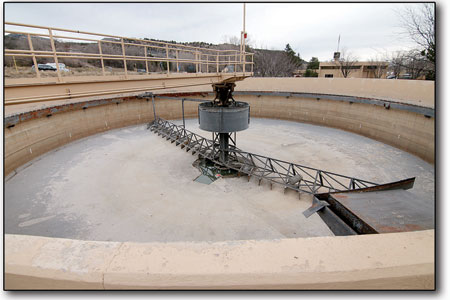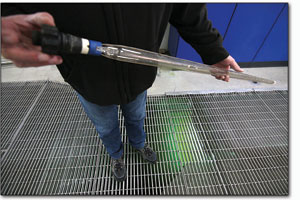 |
|
A sewage container at the City of Durango’s wastewater treatment facility near Santa Rita Park holds waste, creating a sulfurous gas that, without filtration, eats away at the interior of the container. City officials hope to recieve funding to install proper filtration systems and mitigate the issue./Photo by Jennaye Derge
|
Down the line
Water, sewer rate hikes to help fund future needs
by Tracy Chamberlin
After 20 years, the city took a long look at how water and sewer bills are tallied. From having a monthly base rate to bonds for future funding, all the numbers were crunched, calculated and reconsidered.
The result is a new way of doing things that city officials hope will not only cover the cost of operating the water and sewer systems today and fund future improvements. It is hoped it will also prevent dramatic rate increases in years to come.
|
Projected rate hikes over the next 5 years Year Water Sewer 2015 55% 60% 2016 32% 25% 2017 2% 25% 2018 2% 2% 2019 2% 2% – Source: City of Durango |
It’s been two decades since the city performed a detailed Utility Rate Study. Add on the aging water and sewer system plus the changing landscape of clean water regulations, and the city is left with a gap between revenues and expenses.
In response, the city contracted Willdan Financial Services to take a detailed look at the water and sewer funds.
“It’s really taking a step back and taking a comprehensive look at those funds,” said Mary Beth Miles, assistant to the City Manager, who presented the rate study findings to City Council at a Nov. 18 meeting.
Willdan, a California-based company with 50 years of experience working on infrastructure projects, proposed an initial rate increase in 2015 of 114 percent for water and 100 percent for sewer.
City Council responded by asking staff and the Utilities Commission to look for more options. In October, they were able to bring that number down to 80 percent for water and 80 percent for sewer.
Part of the reason the city needed to find the funds so quickly was to meet new state clean water regulations required by 2017. The 60-year old wastewater treatment plant would have needed upgrades to meet those regulations, costing the city millions.
Recently, however, the Colorado Department of Public Health and Environment agreed to give the city another six years, extending the deadline to 2023. This gives the city time to consider other alternatives, like building a new wastewater treatment plant.
The extension also gave the city room to spread out the rate increase, bringing the initial 2015 hike down to 55 percent for water rates and 60 percent for sewer.
Based on average residential usage, which comes to 7,000 gallons of water per month, the old bill would come to $24.23. Under the new model, that bill would come to $33.13.
In 2016, they will go up again, to 32 percent for water and 25 percent for sewer. The following year, in 2017, water get a 2 percent hike and sewer rates see another 25 percent increase. The following year, they will level out at 2 percent a year to keep up with inflation.
By mid-December, Miles said, the city is hoping to have a bill calculator available on its website. Residents can figure out exactly what their bills will be in order to make adjustments to the family budget.
Over the past several months, Willdan, City Council, city staff and the Utilities Commission worked to create a rate structure and investment policy that balances operating costs and future investments, while keeping the water and sewer funds sustainable.
The water and sewer funds, which are not supported by city sales tax revenues and the general fund, are not currently running a deficit. The talks focused on how to upgrade the 60-year-old water treatment plant and the 30-year-old sewer plant.
The additional water revenues from rate increases are expected to tally $1,955,800. Sewer revenues will go up by $1,952,181. Part of the revenues will go toward facilities and part will be used to get water Lake Nighthorse to the city.
It’s not just the rate that’s going to change, however. The structure of bills is also going to change.
Before, for example, water bills had a minimum usage charge of 2,000 gallons but no official base rate. Starting in January, there will be a base rate as well as usage.
The base rate covers 20 percent of what it costs the city to operate the water and sewer facilities. Water usage mainly depends on the classification of a property (residential or commercial) and the size of the water meter. The sewer usage mainly depends on an average taken from January to March.
|
|
During the Nov. 18 public hearing, City Councilors noted the challenges higher water and sewer rates could have on residents’ budgets.
City Councilor Dick White, who is also a liaison on the Utilities Commission, said it’s a painful process, but that the need was great and real.
“I’m pleased that we have a mechanism that will prevent this kind of jump from happening again in the future,” White said.
The second reading of the ordinance changing the rate structure – and likely when City Council will approve it – is scheduled for 6:30 p.m., Tues., Dec 16, at council chambers.
The increase goes into effect Jan. 1, and residents will see the changes on their February bills.
Along with the water and sewer rate increases, the city is updating the Utility Refund Program, which hasn’t been updated since the mid-1990s.
Miles said the proposed changes include eligible income levels, refund amounts and other qualifications. It could open the program up to more residents.
The city ordinance to update the refund program is scheduled for a first reading also at the Dec. 16 council meeting.
For more information on the city’s water and sewer rates, the utility rate study and more, visit www.durangogov.org.

